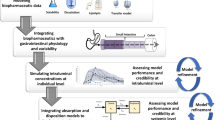Summary
The aim of this study was to investigate whether plasma concentrations of tranexamic acid in surgical patients during total hip replacement can be predicted from pharmacokinetic data from healthy volunteers, and whether therapeutic concentrations are sustained during the period of postoperative bleeding. Ten patients with normal kidney function received 10 mg/kg of tranexamic acid intravenously before surgery and another 10 mg/kg 3 hours later. Plasma concentration curves of tranexamic acid were computer-simulated, based on pharmacokinetic data from a volunteer study. Plasma concentrations in the patients were determined repeatedly and compared with the predicted values. Glomerular filtration rate was determined peroperatively as iohexol clearance. The blood loss was determined per- and postoperatively. The actual plasma concentrations of tranexamic acid were as predicted, or above, in all but two patients. These two were the youngest in the study, with the highest iohexol clearance; in both cases haemodilution was carried out and in one blood recovery with a cell saver was also used during surgery. A therapeutic level (> 10 mg/L) of tranexamic acid was maintained for approximately 8 hours, i.e. during the period of major bleeding. The plasma concentrations of tranexamic acid in surgical patients with normal kidney function can consequently be predicted from studies in healthy volunteers. Targeting of a therapeutic plasma concentration for the desired period of time is thus possible and can form the basis for a rational dosing of tranexamic acid.
Similar content being viewed by others
References
Nilsson IM. Clinical pharmacology of aminocaproic and tranexamic acids. J Clin Pathol 1980; 33 Suppl. 14: 41–7
Verstraete M. Clinical application of inhibitors of fibrinolysis. Drugs 1985; 29: 236–61
Åstedt B. Clinical pharmacology of tranexamic acid. Scand J Gastroenterol 1987; 137 Suppl.: 22–5
Andersson L, Nilsson IM, Niléhn J-E, et al. Experimental and clinical studies on AMCA, the antifibrinolytically active isomer of p-aminomethyl cyclohexane carboxylic acid. Scand J Haematol 1965; 2: 230–47
Andersson L, Nilsson IM, Colleen S, et al. Role of urokinase and tissue activator in sustaining bleeding and the management thereof with EACA and AMCA. Ann NY Acad Sci 1968; 146: 642–58
Hedlund PO. Antifibrinolytic therapy with Cyklokapron in connection with prostatectomy. A double blind study. Scand J Urol Nephrol 1969; 3: 177–82
Walzman M, Bonnar J. Effects of tranexamic acid on the coagulation and fibrinolytic systems in pregnancy complicated by placental bleeding. Arch Toxicol 1982; Suppl. 5: 214–20
Horrow JC, Van Riper DF, Strong MD, et al. The dose-response relationship of tranexamic acid. Anesthesiology 1995; 82: 383–92
Hiippala S, Strid L, Wennerstrand M, et al. Tranexamic acid (cyklokapron) reduces perioperative blood loss associated with total knee arthroplasty. Br J Anaesth 1995; 75: 534–7
Benoni G, Carlsson Å, Petersson C, et al. Does tranexamic acid reduce blood loss in knee arthroplasty? Am J Knee Surg 1995; 8: 88–92
Maki M, Beller FK. Comparative studies of fibrinolytic inhibitors in vitro. Thromb Diath Haemorrh 1966; 16: 668–86
Longstaff C. Studies on the mechanisms of action of aprotinin and tranexamic acid as plasmin inhibitors and antifibrinolytic agents. Blood Coagul Fibrinolysis 1994; 5: 537–42
Eriksson BI, Zachrisson BE, Teger-Nilsson A-C, et al. Thrombosis prophylaxis with low molecular weight heparin in total hip replacement. Br J Surg 1988; 75: 1053–7
Janssens M, Joris J, David JL, et al. High-dose aprotinin reduces blood loss in patients undergoing total hip replacement surgery. Anesthesiology 1994; 80: 23–9
Eriksson O, Kjellman H, Pilbrant Å, et al. Pharmacokinetics of tranexamic acid after intravenous administration to normal volunteers. Eur J Clin Pharmacol 1974; 7: 375–80
Pilbrant Å, Schannong M, Vessman J. Pharmacokinetics and bioavailability of tranexamic acid. Eur J Clin Pharmacol 1981; 20: 65–72
Puigdellívol E, Carral ME, Moreno J, et al. Pharmacokinetics and absolute bioavailability of intramuscular tranexamic acid in man. Int J Clin Pharmacol Ther Toxicol 1985; 23: 298–301
Andersson L, Eriksson O, Hedlund P-O, et al. Special considerations with regard to the dosage of tranexamic acid in patients with chronic renal diseases. Urol Res 1978; 6: 83–8
Krutzén E, Bäck S-E, Nilsson-Ehle I, et al. Plasma clearance of a new contrast agent, iohexol: A method for the assessment of glomerular filtration rate. J Lab Clin Med 1984; 104: 955–61
Vessman J, Strömberg S. Determination of tranexamic acid in biological material by electron capture gas chromatography after direct derivatization in an aqueous medium. Anal Chem 1977; 49: 369–73
Thompson GA, Shumaker RC. MLTIDOSE: a multiple-dose simulation program for linear systems characterized by exponential functions. Drug Metab Rev 1989–90; 21: 463–9
Kluft C, Verheijen JH, Jie AFH, et al. The postoperative fibrinolytic shutdown: a rapidly reverting acute phase pattern for the fast-acting inhibitor of tissue-type plasminogen activator after trauma. Scand J Clin Lab Invest 1985; 45: 605–10
Risberg B. The response of the fibrinolytic system in trauma. Acta Chir Scand 1985; Suppl. 522: 245–71
Author information
Authors and Affiliations
Rights and permissions
About this article
Cite this article
Benoni, G., Björkman, S. & Fredin, H. Application of Pharmacokinetic Data from Healthy Volunteers for the Prediction of Plasma Concentrations of Tranexamic Acid in Surgical Patients. Clin. Drug Invest. 10, 280–287 (1995). https://doi.org/10.2165/00044011-199510050-00005
Published:
Issue Date:
DOI: https://doi.org/10.2165/00044011-199510050-00005




